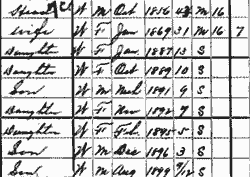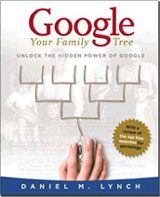|
|
|
|

Census Data
  Census data can provide valuable clues for family historians, but unless you take the time to understand the questions asked, the range of potential answers, as well as the abbreviations used by enumerators (census takers), then you may not get the full benefit from census data.
Census data can provide valuable clues for family historians, but unless you take the time to understand the questions asked, the range of potential answers, as well as the abbreviations used by enumerators (census takers), then you may not get the full benefit from census data.
In a general sense, the census data collected increased with each census. The early efforts simply collected the name of head of household and a count of persons in other age or gender categories. As the decades passed however, census data became much more valuable. Depending upon the year and the diligence of the enumerator, you may have more than a dozen clues from a single census entry.
Looking Closely at Census Data
We will briefly discuss each element of census data that you may find on a U.S. Federal Census Population Schedule. Note that not all data elements are included for all census years, but this is simply a means to describe census data and how each can be interpreted for genealogy research.

Location of Household
The more recent U.S. Census include the street name, house number, and the sequential number assigned to a structure in order of visitation by the census enumerator. A three-family home, for instance, would show an address (1234 West Main Street), as well as a number (e.g. - 23 if it was the 23 structure visited by the enumerator). Each individual family within the household would also be assigned a number in order of visitation, but the household number would not increment until visiting the next structure.
Household Data
Owned or Rented, Value of Home (if owned) or Monthly Rental (if rented)
Name of Persons as of Census Date
The official census date is an important concept to understand when doing census research. Where an exact date of birth is not known, one can sometimes be narrowed down to a short window based on the census date. You can view a summary table of census dates as part of our census overview page.
Relationship to Head of Household
First appearing in 1880, this one data field can be esepcially helpful in documenting relationships between members of the same household, especially those having different surnames. Common values are head, wife, son, daughter, mother, father, brother, sister, son-in-law, daughter-in-law, grandmother, grandfather, border, servant, adopted-daughter, adopted-son, and others.
Personal Description
Gender, Color or Race, Age at last birthday, Marital Status.
Education
This changed over time, but generally describes whether or not an individual 'Can Read', 'Can Write', and 'Can Speak' (English).
Place of Birth
For many, this can be one of the more important data fields, but it will depend upon how diligent the enumerator was in recording information for each individual. It is common to find a state or country name listed, but sometimes you may find a more descriptive name. Keep in mind that the name recorded may have changed over time, so you may have to do further research to determine where and when some countries changed their name.
Citizenship
Whether a naturalized U.S. citizen (Na) or Alien (Al). If an individual had filed an initial Declaration of Intention, they would be shown as Papers filed (Pa). Some census years also indicate a year of arrival to the United States.

If you have comments or questions about the content of the Census Records page,
please contact us at your convenience.
|
|



